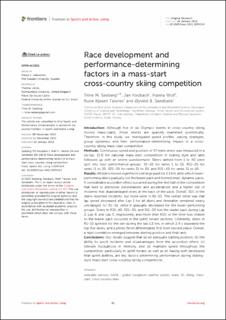| dc.description.abstract | Introduction: Although five of six Olympic events in cross-country skiing involve mass-starts, those events are sparsely examined scientifically. Therefore, in this study, we investigated speed profiles, pacing strategies, group dynamics and their performance-determining impact in a cross-country skiing mass-start competition.
Methods: Continuous speed and position of 57 male skiers was measured in a six-lap, 21.8 km national mass-start competition in skating style and later followed up with an online questionnaire. Skiers ranked from 1 to 40 were split into four performance-groups: R1–10 for ranks 1 to 10, R11–20 for ranks 11 to 20, R21–30 for ranks 21 to 30, and R31–40 for ranks 31 to 40.
Results: All skiers moved together in one large pack for 2.3 km, after which lower-performing skiers gradually lost the leader pack and formed small, dynamic packs. A considerable accordion effect occurred during the first half of the competition that lead to additional decelerations and accelerations and a higher risk of incidents that disadvantaged skiers at the back of the pack. Overall, 31% of the skiers reported incidents, but none were in R1–10. The overall trend was that lap speed decreased after Lap 1 for all skiers and thereafter remained nearly unchanged for R1–10, while it gradually decreased for the lower-performing groups. Skiers in R31–40, R21–30, and R11–20 lost the leader pack during Lap 3, Lap 4, and Lap 5, respectively, and more than 60% of the time-loss relative to the leader pack occurred in the uphill terrain sections. Ultimately, skiers in R1–10 sprinted for the win during the last 1.2 km, in which 2.4 s separated the top five skiers, and a photo finish differentiated first from second place. Overall, a high correlation emerged between starting position and final rank.
Conclusions: Our results suggest that (a) an adequate starting position, (b) the ability to avoid incidents and disadvantages from the accordion effect, (c) tolerate fluctuations in intensity, and (d) maintain speed throughout the competition, particularly in uphill terrain, as well as (e) having well-developed final sprint abilities, are key factors determining performance during skating-style mass-start cross-country skiing competitions. | en_US |

